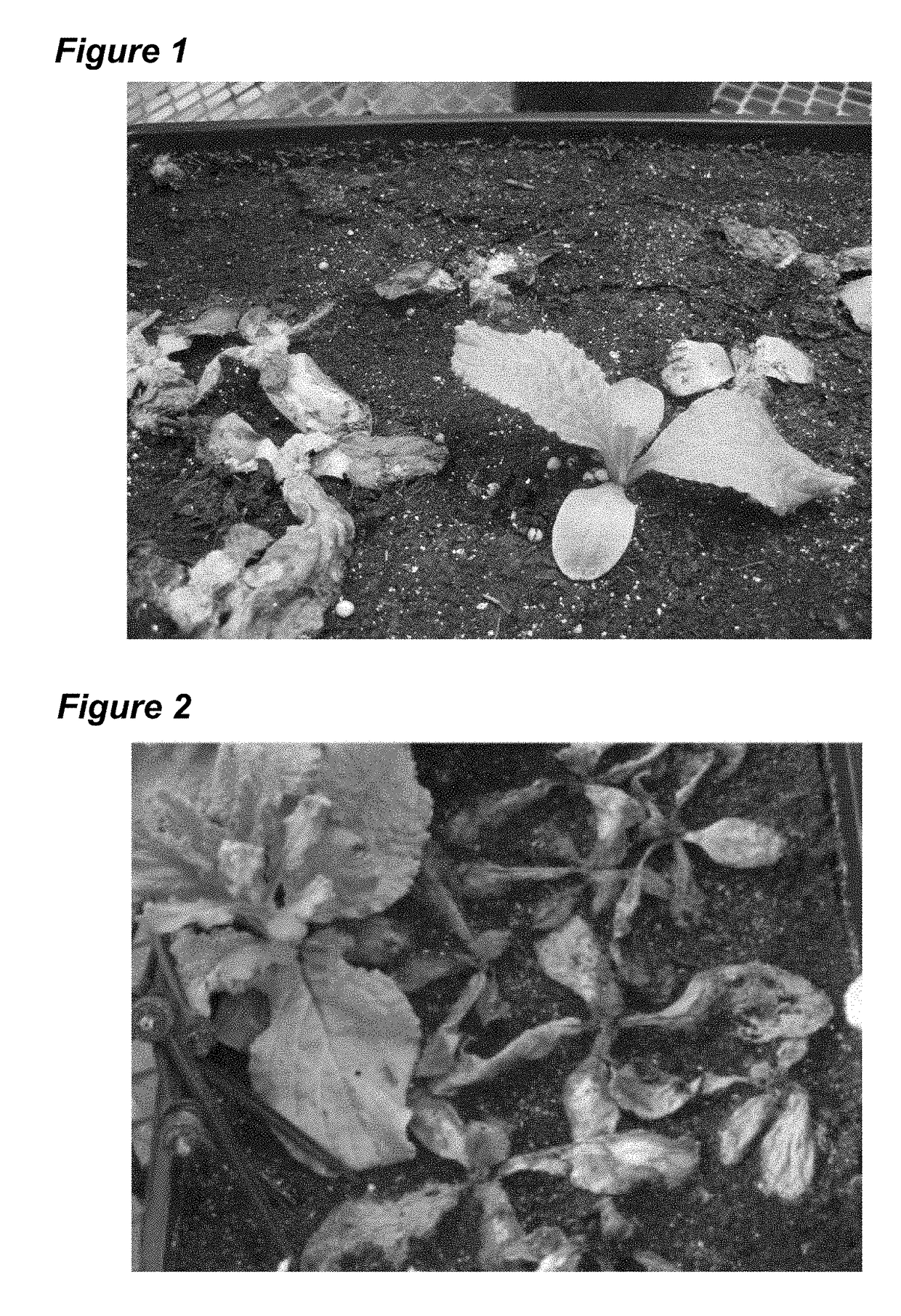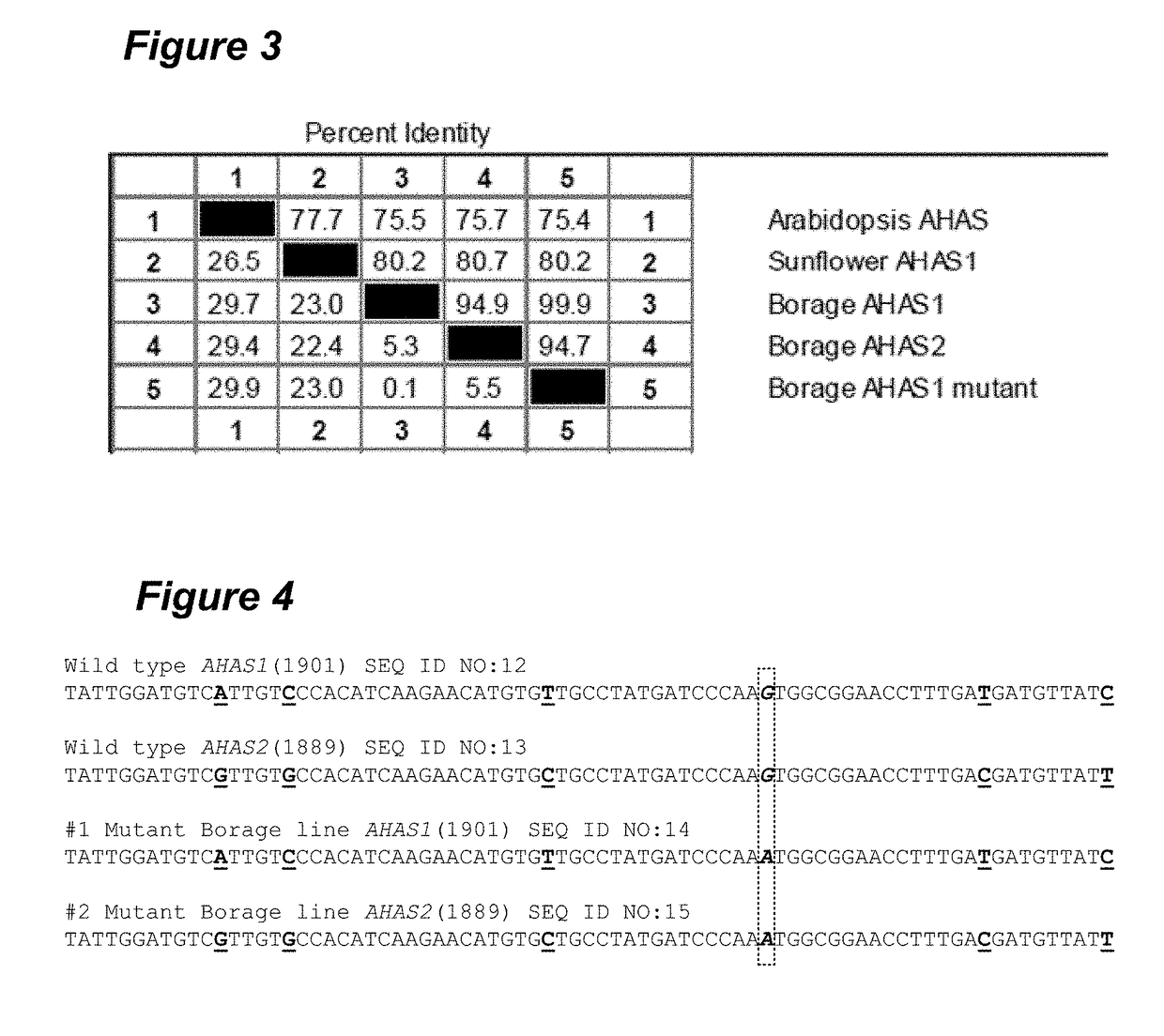Imidazolinone herbicide resistant borage
a technology of herbicide resistance and borage, which is applied in the direction of plant growth regulators, biocide, enzymes, etc., can solve the problems of increasing the cost of borage production, fewer farmers willing to work, and losing billions of dollars, so as to achieve the effect of high activity
- Summary
- Abstract
- Description
- Claims
- Application Information
AI Technical Summary
Benefits of technology
Problems solved by technology
Method used
Image
Examples
example 1
Chemically Induced Mutagenesis of Borage
[0047]Ethyl methanesulfonate (EMS), a chemical mutagen, can induce nucleotide mismatching and base changes in a genome resulting in genetic mutations. Under the effect of EMS, guanine (G) undergoes alkylation to form O6-ethylguanine, which prefers thymine (T) to cytosine (C) pairing during DNA synthesis; thereby the original G / C pair is replaced by A (adenine) / T pair. The nucleotide substitution could lead to changes of amino acids at critical positions resulting in sensitivity variations to herbicides. Although the mutation occurs to M1 plants, mutant phenotypes may or may not be shown in the M1 generation because most mutations are genetically recessive. Self-pollination of M1 to produce M2 is necessary to allow heterozygous mutants to segregate resulting in variations in mutant phenotypes, thus M2 plants are screened for herbicide resistance. EMS mutagenesis has been used to produce imidazolinone resistant Arabidopsis and other plant specie...
example 2
Cloning of Borage AHAS Genes and Identification of the Point Mutation Responsible for Imidazolinone Resistance
[0063]The acetohydroxyacid synthase (AHAS) (EC 4.1.3.18), also known as acetolactate synthase (ALS), catalyzes the first reaction in the pathway for synthesis of branched chain amino acids leucine, isoleucine and valine in plants and microorganisms. AHAS plays a critical role to ensure a balance supply of the amino acids as well as producing intermediates to interact with other cellular metabolic pathways. In plants, the gene encoding AHAS enzyme, AHAS, is generally expressed in a constitutive manner, but expression level may vary between tissues and developmental stages. The identity of AHAS protein sequences among different species ranges from 17% to 90%, and certain key residues of AHAS enzymes are absolutely conserved across species. Imidazolinone herbicides control weeds by inhibiting activity of the native AHAS enzyme, thus natural mutation or chemical induced mutation...
example 3
Development of KASP SNP Marker Linked to Imidazolinone Resistance Gene (AHAS1 Mutation) in Borage
[0081]The herbicide resistant mutation is generally dominant; therefore genotypes of homozygous and heterozygous tolerant plants are difficult to distinguish from their phenotypes. However, since imizadolinone resistance of borage is induced by a single nucleotide substitution, the SNP can be detected by KASP technology and used as a marker to distinguish the genotypes. The KASP genotyping system is an accurate and cost-effective fluorescence-based technology developed by KBioscience for high-throughput SNPs genotyping.
[0082]The technology is based on allele-specific oligo extension and fluorescence resonance energy transfer (FRET) for signal generation. Two allele-specific primers and one allele common primer are included in a KASP genotyping assay. Each allele-specific primer must be ended with a specific nucleotide of the SNP and attached with unique unlabeled tail sequences at the 5′...
PUM
| Property | Measurement | Unit |
|---|---|---|
| height | aaaaa | aaaaa |
| molecular mass | aaaaa | aaaaa |
| molecular mass | aaaaa | aaaaa |
Abstract
Description
Claims
Application Information
 Login to View More
Login to View More - R&D
- Intellectual Property
- Life Sciences
- Materials
- Tech Scout
- Unparalleled Data Quality
- Higher Quality Content
- 60% Fewer Hallucinations
Browse by: Latest US Patents, China's latest patents, Technical Efficacy Thesaurus, Application Domain, Technology Topic, Popular Technical Reports.
© 2025 PatSnap. All rights reserved.Legal|Privacy policy|Modern Slavery Act Transparency Statement|Sitemap|About US| Contact US: help@patsnap.com



